 Canaletto, St. Mark's Square, circa 1730, Fogg Art Museum
Canaletto, St. Mark's Square, circa 1730, Fogg Art Museum
Who was Canaletto?
Canaletto, real name Giovanni Antonio Canal, was born on October 28, 1697 in Venice, Italy. He is considered one of the greatest painters of vedute (views of urban landscapes) of his time.
The son of a theater set painter, Canaletto was trained in painting by his father. He also worked with his brother, Bernardo Canal, who was also a painter. Canaletto began his career as a theater artist, painting sets for plays performed in Venice.
In the 1720s Canaletto began to paint vedute of Venice. His paintings quickly attracted attention and he was hired by wealthy clients to paint views of Venice and other Italian cities. Canaletto was particularly known for his ability to capture the light and atmosphere of the city of Venice.
Canaletto traveled to England several times during his life, where he painted views of London and other British cities. He was invited by King George III to become a court painter. Canaletto spent the last part of his life in Venice, where he died on April 19, 1768.
Canaletto's work has influenced many artists, including English painters William Turner and John Constable. His paintings are valued for their precision and attention to detail, as well as their artistry. Today, many of Canaletto's paintings are found in public and private collections around the world.
What is Vedutism?
Vedutism is an 18th-century Italian art movement characterized by the realistic depiction of cityscapes, including panoramic views of Venice. The term "veduta" means "view" in Italian and refers to the precise and detailed representations of cities and their monuments.
Vedutist artists were often painters who specialized in depicting urban landscapes, such as Canaletto, Francesco Guardi and Bernardo Bellotto. They used linear perspective techniques to create an illusion of depth and realism in their works.
Vedutist paintings were often commissioned by aristocrats and wealthy travelers who wanted to take home a souvenir of their trip to Venice. Vedutist artists were renowned for their ability to accurately reproduce the buildings and monuments of the city, as well as their skill in capturing the play of light and reflections on the canals.
In summary, Vedutism is an 18th-century Italian art movement that is characterized by the accurate and detailed depiction of cityscapes, especially panoramic views of Venice. Vedutist artists used linear perspective techniques to create an illusion of depth and realism in their works.
Who are Canaletto's first customers?
Canaletto's first clients were private Venetian collectors who were interested in his realistic and detailed views of Venice. His first commissions were for views of Piazza San Marco, city canals and Venetian palaces. These collectors appreciated the precision of his paintings and the way he captured the distinctive features of the city.
Over time, Canaletto began to receive commissions from foreign clients, including European collectors, such as Prince Augustus III of Saxony and Count Brühl of Poland. He also painted views of other Italian cities, such as Rome, Florence, and Naples.
During the 1730s, Canaletto began to receive orders from British customers. He traveled to England in 1746 for the first time and was immediately hired to paint views of London. His most important commissions in England were for clients such as the Duke of Richmond and the Duke of Bedford.
In summary, Canaletto's first clients were private Venetian collectors, but he quickly gained popularity with wealthy and influential foreign clients.
However, his popularity also caught the attention of forgers, who began producing copies of his paintings. To protect his reputation, Canaletto began putting his signature on all of his works.
Canaletto's encounter with art dealer Joseph Smith
Canaletto's encounter with Joseph Smith was decisive for the career of the Venetian painter. In 1729, Joseph Smith, a British merchant established in Venice, bought two paintings by Canaletto, including a view of Piazza San Marco. Impressed by the quality and precision of Canaletto's paintings, Smith began regularly purchasing works by the artist.
In 1740 Smith returned to England with over 200 paintings by Canaletto, which he exhibited in his London gallery. The paintings attracted great interest from British collectors and sold for high prices. In fact, Canaletto's popularity in England was largely due to Smith's promotion of his work.
In 1746 Canaletto visited England for the first time, probably at Smith's invitation. He was enthusiastically received by British collectors and soon began receiving commissions for views from London. These paintings, which depicted sites such as the River Thames, the Palace of Westminster and London Bridge, were very popular with British patrons and helped to cement Canaletto's reputation as a world-renowned artist.
Canaletto's meeting with Joseph Smith was therefore crucial for his career, giving him access to the British market and making his work known to a wider audience.
Trip to England
Canaletto's English period was a period of great productivity and success for the Venetian painter. He arrived in London in 1746 and was immediately hired to paint views of the city by wealthy and influential British clients. He worked for successful dukes, earls and businessmen, painting views of their estates and famous London landmarks.
While in England, Canaletto produced around 50 London paintings, some of which are considered his finest works. His paintings depict views of the River Thames, the Palace of Westminster, London Bridge and the Tower of London, among other famous landmarks in the city. He also painted views of English landscapes, such as parks and gardens, as well as portraits of English high society.
Canaletto adapted his style of painting to suit the tastes and expectations of his British clients. His paintings of London are brighter and more colorful than his views of Venice, with warmer tones and increased attention to architectural detail. He also added figures to his paintings to add visual interest and to give a sense of daily life in the city.
Canaletto's English period was a great success for the painter, who gained popularity with British collectors and was recognized as one of the finest artists of his time. His London paintings helped to enhance his reputation as a world-renowned artist and opened up new avenues for his career. Canaletto returned to Venice in 1755, but his work in England had a lasting influence on British art and continues to be admired by art lovers today.
Paintings from the English period
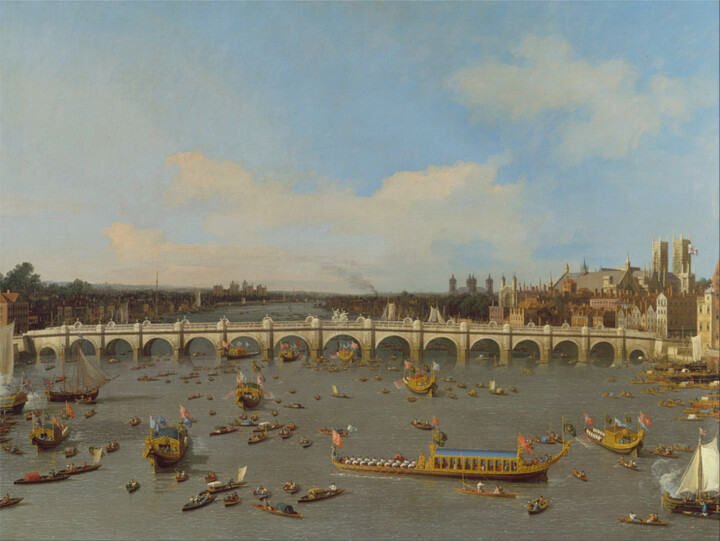 Canaletto, Westminster Bridge on the Lord Mayor's Day, 1746, Yale Center for British Art
Canaletto, Westminster Bridge on the Lord Mayor's Day, 1746, Yale Center for British Art
- The painting "Westminster Bridge on the Day of the Lord Mayor's Entry into Office" is a famous work by Canaletto, made during his English period. The painting depicts Westminster Bridge, seen from the south bank of the River Thames, with crowds gathering to celebrate the swearing in of the Lord Mayor of London.
The scene is filled with architectural detail, with Westminster Bridge in the backdrop and prominent city buildings in the foreground. Human figures add visual interest to the painting, with figures dressed in elegant costumes and dresses for the occasion. Boats on the Thames and flags waving in the wind add to the festive atmosphere of the scene.
The painting is characteristic of Canaletto's style, with great attention to architectural detail and perspective. Colors are vibrant and bright, with a palette that perfectly captures the sunlight on the River Thames and surrounding buildings.
The painting was made in 1747 and is now kept at the Yale British Art Center (USA) .
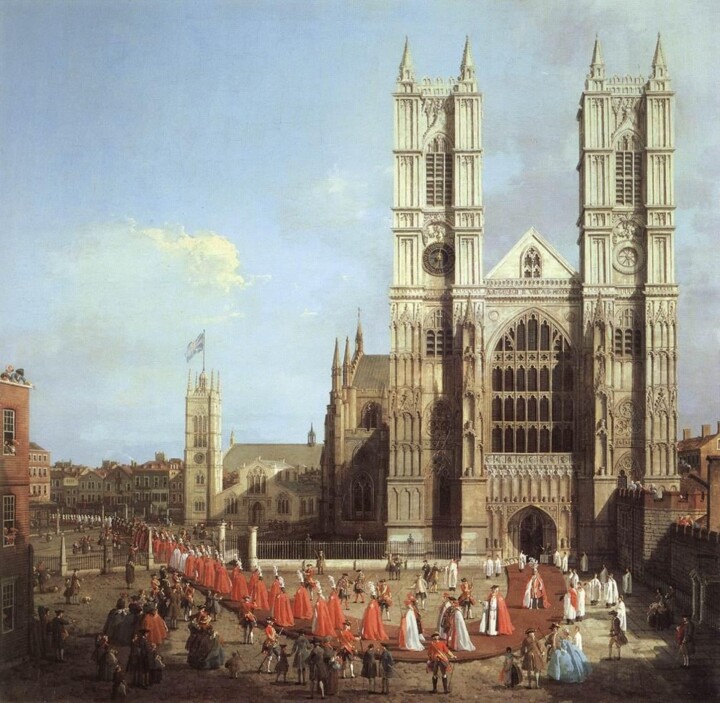 Canaletto, Westminster Abbey with the Procession of the Order of the Bath, 1749, Westminster Abbey
Canaletto, Westminster Abbey with the Procession of the Order of the Bath, 1749, Westminster Abbey
- The painting "Westminster Abbey with the Procession of the Order of the Bath" is a famous work by Canaletto, made during his English period. The painting depicts the famous Westminster Abbey, with the annual Order of the Bath procession taking place in the inner courtyard.
The scene is filled with architectural detail, with the towering abbey in the background and buildings and human figures in the foreground. Human figures add visual interest to the painting, with figures dressed in elegant costumes and dresses for the occasion. Banners and flags add to the festive atmosphere of the scene.
The painting is characteristic of Canaletto's style, with great attention to architectural detail and perspective. Colors are vibrant and bright, with a palette that perfectly captures the sunlight on the Abbey courtyard.
The painting was made in 1749 and is now kept at Wastminster Abbey. It is considered an iconic representation of life in London during the 18th century.
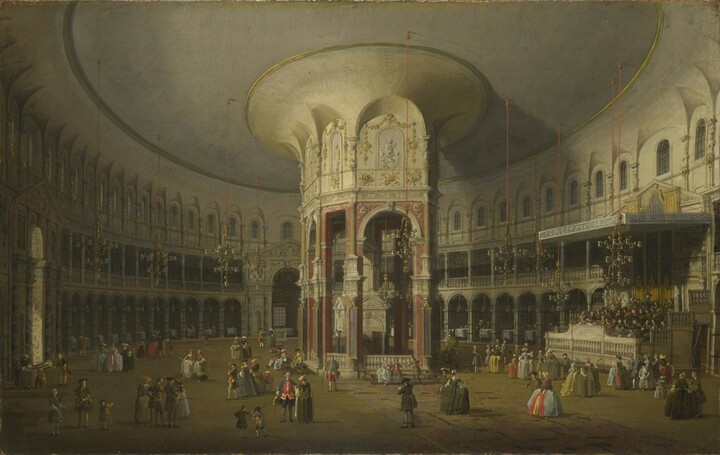 Canaletto, The Rotunda of Ranelagh, 1754, London, National Gallery
Canaletto, The Rotunda of Ranelagh, 1754, London, National Gallery
- The painting "La Rotonde de Ranelagh" is a famous work by Canaletto, made during his English period. The painting depicts the famous Ranelagh Rotunda, a ballroom in London's Ranelagh Gardens, which was one of the city's most popular entertainment venues in the 18th century.
The scene is filled with architectural detail, with the towering rotunda in the background and buildings and human figures in the foreground. Human figures add visual interest to the painting, with figures dressed in elegant costumes and dresses for the occasion. Musicians playing music and dancers on the dance floor add to the festive atmosphere of the scene
The painting is characteristic of Canaletto's style, with great attention to architectural detail and perspective. The colors are bright and bright, with a palette that perfectly captures the sunlight on the surrounding gardens.
The painting was made in 1754 and is now housed in the National Gallery in London.
The return to Italy in Venice
After returning to Venice in 1755, Canaletto continued to paint views of his native town, particularly of St. Mark's Square, where he had previously worked. His views of Piazza San Marco are considered some of his finest works, and he is also known for painting views of the lagoon and its surrounding islands.
Although he was elected a member of the Academy of Fine Arts in Venice in 1763, Canaletto never regained the popularity he had enjoyed in his youth. The Venetian art market had changed, with the emergence of new artists and new styles, and Canaletto found it difficult to adapt to these new trends. However, he continued to work until his death in 1768, leaving behind a rich collection of works that continue to fascinate art lovers around the world.
The techniques developed by Canaletto
Canaletto was known for his depictions of Venice and its cityscapes. He developed painting techniques that contributed to the realization of his characteristic works. Here are some of these techniques:
- The use of camera obscura: Canaletto used a darkroom to help create precise and detailed images of Venice. This technique involves projecting an image onto a flat surface and tracing it to achieve precise lines and precise perspectives.
- Mastery of perspective: Canaletto was famous for his ability to create precise perspective in his paintings. He used horizon lines and vanishing points to give the impression of depth and distance.
- The painting of small details: Canaletto was careful to paint small details in his works, such as human figures, boats and birds. These details add life and interest to his paintings.
- The use of color: Canaletto used bold, bright colors to depict the buildings and water of Venice. He also used complementary colors to create interesting visual contrasts.
- Use of light: Canaletto used light to create dramatic effects in his works. He painted reflections on water, shadows on buildings and effects of sunlight to give depth and texture to his paintings.
Canaletto's successors
After Canaletto's death in 1768, several artists continued to paint cityscapes and views of Venice in the characteristic style of the Venetian master. Here are some of the best-known Canaletto successors:
- Bernardo Bellotto: Nephew of Canaletto, Bellotto studied with his uncle and also adopted his precise and detailed style of painting. He worked in Dresden for the King of Poland, where he produced views of the city and surrounding area.
- Francesco Guardi: A contemporary Venetian artist of Canaletto, Guardi adopted a freer and more atmospheric style. His paintings of Venice are often darker and more romantic than those of Canaletto.
Michele Marieschi: Marieschi was another Venetian artist who worked in the style of Canaletto. His paintings of Venice are often more atmospheric than those of Canaletto, and he also painted landscapes of the Venetian countryside.
Francesco Lazzaro Guardi: Younger brother of Francesco Guardi, Lazzaro also worked in the style of Canaletto, but his paintings tended to be brighter and more colorful than those of his brother. He also painted genre scenes, portraits and still lifes.
These artists all contributed to the continuation of Canaletto's style and each brought their own personal touch to the depiction of Venice and its cityscapes.
Quotes from Canaletto
"I don't paint what I see, I paint what I feel."
"The true purpose of art is to make the invisible visible."
"Beauty is not in the things themselves, but in the way we see them."
"A good painting is a journey into a world where things are more beautiful than in reality."
"Perspective is the golden chain that unites all the elements of a painting."
These quotes reflect Canaletto's view of art as a means to transcend reality and capture the essence of what he saw. They also testify to his deep understanding of perspective and its role in the creation of a work of art.
Some famous works by Canaletto
 Canaletto, The Grand Canal from the Balbi Palace to the Rialto, circa 1723, Venice, Ca' Rezzonico
Canaletto, The Grand Canal from the Balbi Palace to the Rialto, circa 1723, Venice, Ca' Rezzonico
- "The Grand Canal from the Balbi Palace to the Rialto" is one of Canaletto's most famous paintings. Made in 1722-1723, this oil painting on canvas measures approximately 207 cm wide by 144 cm high. It is currently housed in the 18th century Ca' Rezzonico Museum in Venice, Italy.
The painting depicts a view of the Grand Canal of Venice from the Palazzo Balbi, towards the famous Rialto Bridge. Many rowing boats, gondolas and cargo ships can be seen cruising the canal. The buildings along the banks are depicted with great precision and attention to architectural detail. Sunlight hits the colorful building facades and creates shimmering reflections on the water.
The painting is a typical example of Canaletto's style, which is characterized by precise perspectives, painstaking detail, and skillful use of light and color to create atmospheric effects.
 Canaletto, San Giovanni and Paolo and the Scuola di San Marco, around 1725, Gemäldegalerie Alte Meister, Dresden (Germany)
Canaletto, San Giovanni and Paolo and the Scuola di San Marco, around 1725, Gemäldegalerie Alte Meister, Dresden (Germany)
- "Saint Giovanni and Paolo and the Scuola di San Marco" is an oil painting on canvas made by Canaletto around 1725. The painting measures approximately 165cm wide by 125cm high and is currently kept at the Gemäldegalerie Alte Meister in Dresden in Germany.
The painting shows the facade of the Church of San Giovanni e Paolo in Venice, with the Scuola Grande di San Marco on the left side of the canvas. Figures can be seen moving past the buildings, as well as gondolas on the canal that runs alongside the church. Sunlight hits the buildings and creates subtle shadows and reflections on the water.
The composition is typical of Canaletto's style, with precise perspective and great attention to architectural detail. The painting is a perfect example of Canaletto's skill in depicting Venice with great precision and beauty. The richness of the colors and the luminosity of the canvas give an impression of life to the scene, reinforcing the impression of realism and liveliness that characterize Canaletto's work.
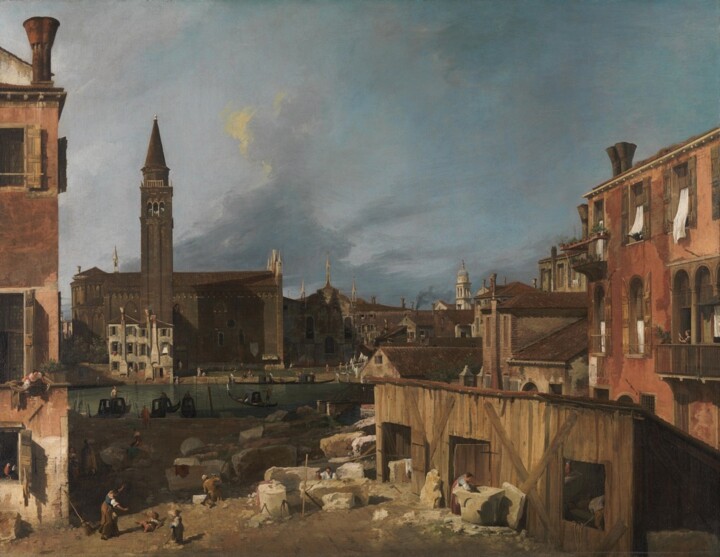 Canaletto The Stonemason's Court, circa 1728, National Gallery, London
Canaletto The Stonemason's Court, circa 1728, National Gallery, London
- "The Stonemason's Courtyard" is an oil painting on canvas made by Canaletto in 1727-1728. This work measures approximately 163cm wide by 124cm high and is currently housed in the National Gallery in London.
The painting depicts a typical Venetian courtyard, with colorful buildings and figures going about their daily lives. The title of the work refers to the main character, a stonemason seated on a bench in the center of the courtyard, working on a piece of marble. Around it, one can see workers, children and animals, as well as buildings with bright colors and precise architectural details.
The composition is typical of Canaletto's style, with precise perspective and great attention to detail. The painting shows daily life in Venice, with great precision and beauty. The sunlight, which filters through the buildings, creates subtle shadows and reflections on the walls and cobblestones, reinforcing the impression of realism of the scene.
In summary, "The Stonemason's Courtyard" is an important work by Canaletto that exemplifies his talent for depicting scenes of everyday Venetian life with great precision and beauty. The painting's composition, with its precise perspective and skilful use of light and color, is a typical example of Canaletto's style.
 Canaletto, Regatta on the Grand Canal, 1740, National Gallery, London
Canaletto, Regatta on the Grand Canal, 1740, National Gallery, London
- "The Regatta on the Grand Canal" is a famous oil on canvas painting by Canaletto circa 1740. This work measures approximately 183cm wide by 122cm high and is currently housed in the National Gallery, London.
The painting depicts a traditional boat race that takes place on the Grand Canal in Venice. In the foreground, gondolas and rowing boats can be seen preparing for the race, with rowers paddling and spectators cheering them on from the banks of the canal. In the background, we can see the emblematic buildings of Venice, such as the Doge's Palace, Saint Mark's Basilica and the Clock Tower.
The composition is typical of the style of Canaletto, with great precision in the architectural details and a precise perspective that creates an impression of depth and realism. The painting is also notable for its skillful use of light and color. The reflections of light on the water create subtle light and shadow effects that add an extra dimension to the scene.
In summary, "The Regatta on the Grand Canal" is an iconic work by Canaletto that exemplifies his talent for depicting scenes of daily life in Venice with great precision and beauty. The painting's composition, with its precise perspective and skilful use of light and color, is a typical example of Canaletto's style.

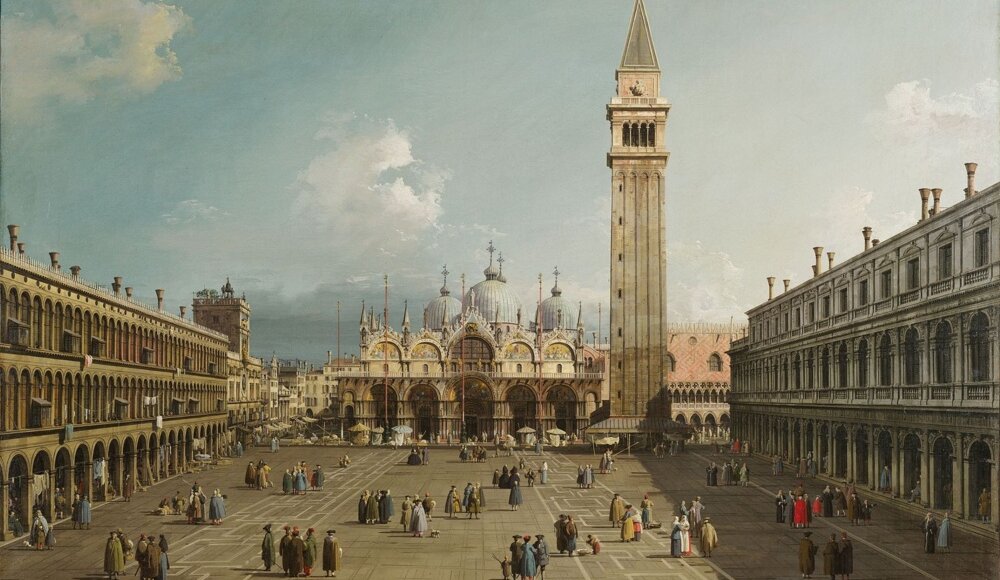
 Jean Dubreil
Jean Dubreil





